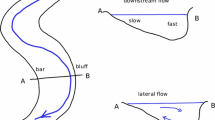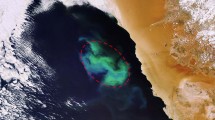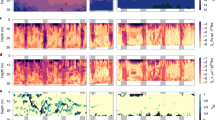Abstract
Chaotic systems are sensitive to small changes in parameters and initial conditions, but are spatially distributed chaotic populations sensitive to the location of perturbations within their domain? Here, we examine the transient responses to perturbation in a density-dependent population model with asymmetrical dispersal, where offspring are moved some distance downstream of the parent population and diffusively spread, an appropriate approximation for species in streams, rivers, and ocean currents. We find that over a portion of the studied parameter space, our system displays extreme convective instability; that is, an arbitrarily small point-source perturbation to the upstream region grows and propagates downstream (in our finite one-dimensional domain, the current moves offspring preferentially in the downstream direction). We can then divide our domain into distinct upstream and downstream regions based on the response to perturbation. A perturbation to the upstream region will create transient downstream instability, and a perturbation to the downstream region has no qualitative effect on the population. We investigate the factors affecting the existence/size of the sensitive upstream region, discuss the ecologically relevant time scales of the transient dynamics following a perturbation, and consider the ecological implications of managing and predicting a population with transient amplification of perturbations.











Similar content being viewed by others
References
Anderson KE, Nisbet RM, Diehl S, Cooper SD (2005) Scaling population responses to spatial environmental variability in advection-dominated systems. Ecol Lett 8:933–943
Anderson KE, Nisbet RM, McCauley E (2008) Transient responses to spatial perturbations in advective systems. B Math Biol 70:1480–1502
Anderson KE, Hilker FM, Nisbet RM (2012) Directional biases and resource-dependence in dispersal generate spatial patterning in a consumer-producer model. Ecol Lett 15:209–217
Basson M, Fogarty MJ (1997) Harvesting in discrete-time predator-prey systems. Math Biosci 141:41–74
Beninca E, Huisman J, Heerkloss R, Johnk KD, Branco P, Van Nes EH, Scheffer M, Ellner SP (2008) Chaos in a long-term experiment with a plankton community. Nature 451:822–825
Berryman AA (1991) Can economic forces cause ecological chaos? The case of the Northern California Dungeness crab fishery [Cancer magister]. Oikos 62(1):106–109
Billings SA, Glaser SM, Boone AS, Stephen FM (2015) Nonlinear tree growth dynamics predict resilience to disturbance. Ecosphere 6(11):1–13
Byers JE, Pringle JM (2006) Going against the flow: retention, range limits and invasions in advective environments. Mar Ecol Prog Ser 313:27–41
Carnegie RB, Burreson EM (2011) Declining impact of an introduced pathogen: Haplosporidium nelsoni in the oyster Crassostrea virginica in Chesapeake Bay. Mar Ecol Prog Ser 432:1–15
Chesson P, Lee CT (2005) Families of discrete kernels for modeling dispersal. Theor Popul Biol 67:241–256
Dennis B, Desharnais RA, Cushing JM, Henson SM, Constantio RF (2001) Estimating chaos and complex dynamics in an insect population. Ecol Monogr 71(2):277–303
Dixon PA, Milicich MJ, Sugihara G (1999) Episodic fluctuations in larval supply. Science 283:1528–1530
Fisher RA (1937) The wave of advance of advantageous genes. Ann Eugenics 7:269
Glaser SM, Ye H, Maunder M, MacCall A, Fogarty MJ, Sugihara G (2011) Detecting and forecasting complex nonlinear dynamics in spatially structured catch-per-unit-effort time series for North Pacific albacore (Thunnus alalunga). Can J Fish Aquat Sci 68(3):400–412
Glaser SM, Fogarty MJ, Liu H, Altman I, C-h H, Kaufman L, MacCall AD, Rosenberg AA, Ye H, Sugihara G (2014) Complex dynamics may limit prediction in marine fisheries. Fish Fish 15(4):616–633
Hastings A, Higgins K (1994) Persistence of transients in spatially structured ecological models. Science 263(5150):1133–1136
Hastings A, Hom CL, Ellner S, Turchin P, Godfray HCJ (1993) Chaos in ecology: is mother nature a strange attractor? Annu Rev Ecol Syst 24(1):1–33
Hsieh C, Reiss CS, Hunter JR, Beddington JR, May RM, Sugihara G (2006) Fishing elevates variability in abundance of exploited species. Nature 443(7133):859–862
Jiang Y, Parmananda P (1998) Spatial coherence in an open flow model. Phys Rev E 57(3):R2499–R2502
Kaneko K (1984) Period-doubling of kink-antikink patterns, quasiperiodicity in antiferro-like structures and spatial intermittency in coupled logistic lattice. Toward a prelude of a “field theory of chaos”. Prog Theor Phys 72(3):480–486
Kaneko K (1992) Overview of coupled map lattices. Chaos 2(3):279–282
Klein ES, Glaser SM, Jordaan A, Kaufman L, Rosenberg AA (2016) A complex past: historical and contemporary fisheries demonstrate nonlinear dynamics and a loss of determinism. Mar Ecol Prog Ser 557:237–246
Kot M, Schaffer WM (1986) Discrete-time growth-dispersal models. Math Biosci 80:109–136
Lind PG, Corte-Real J, Gallas JAC (2002) Modeling velocity in gradient flows with coupled-map lattices with advection. Phys Rev E 66:016219
Lutscher F, Pachepsky E, Lewis MA (2005) The effect of dispersal patterns on stream populations. SIAM Rev 47(4):749–772
Lutscher F, Lewis MA, McCauley E (2006) Effects of heterogeneity on spread and persistence in rivers. B Math Biol 68:2129–2160
Lyapunov AM (1992) General problem of the stability of motion. CRC Press, London; Washington, DC
Marshall DJ, Krug PJ, Kupriyanova EK, Bryne M, Emlet RB (2012) The biogeography of marine invertebrate life histories. Annu Rev Ecol Evol Syst 43:97–114
May RM (1973) Stability and complexity in model ecosystems. Princeton University Press
May RM (1976) Simple mathematical models with very complicated dynamics. Nature 261(5560):459–467
May RM, Oster GF (1976) Bifurcations and dynamic complexity in simple ecological models. Am Nat 110(974):573–599
Mesinger F, Arakawa A (1976) Numerical methods used in atmospheric models, vol 1. International Council of Scientific Unions – World Meteorological Organization, Geneva
Moore JL, Lipcius RN, Puckett B, Schreiber SJ (2016) The demographic consequences of growing older and bigger in oyster populations. Ecol Appl 26(7):2206–2217
Neubert MG, Caswell H (1997) Alternatives to resilience for measuring the responses of ecological systems to perturbation. Ecology 78(3):653–665
Neubert MG, Caswell H, Murray JD (2002) Transient dynamics and pattern formation: reactivity is necessary for Turing instabilities. Math Biosci 175:1–11
Neubert MG, Klanjscek T, Caswell H (2004) Reactivity and transient dynamics of predator-prey and food web models. Ecol Model 179:29–38
Pachepsky E, Lutscher F, Nisbet RM, Lewis MA (2005) Persistence, spread, and the drift paradox. Theor Popul Biol 67:61–73
Pershing AJ, Greene CH, Jossi JW, O’Brein L, Brodziak JKT, Bailey BA (2005) Interdecadal variability in the Gulf of Maine zooplankton community, with potential impacts on fish recruitment. ICES J Mar Sci 62(7):1511–1523
Petrovskii S, Li B-L, Malchow H (2003) Quantification of the spatial aspect of chaotic dynamics in biological and chemical systems. B Math Biol 65:425–446
Pringle JM, Wares JP (2007) Going against the flow: maintenance of alongshore variation in allele frequency in a coastal ocean. Mar Ecol Prog Ser 335:69–84
Pringle JM, Lutscher F, Glick E (2009) Going against the flow: effects of non-Gaussian dispersal kernels and reproduction over multiple generations. Mar Ecol Prog Ser 377:13–17
Rudzick O, Pikovsky A (1996) Unidirectionally coupled map lattice as a model for open flow systems. Phys Rev E 54(5):5107–5115
Schaffer WM (1985) Order and chaos in ecological systems. Ecology 66(1):93–106
Scheffer M, Rinaldi R, Huisman J, Weissing FJ (2003) Why plankton communities have no equilibrium: solutions to the paradox. Hydrobiologia 491:9–18
Sherratt JA, Smith MJ, Rademacher JDM (2009) Locating the transition from periodic oscillators to spatiotemporal chaos in the wake of invasion. Proc Natl Acad Sci 106(27):10890–10895
Siegel DA, Kinlan BP, Gaylord B, Gaines SD (2003) Lagrangian descriptions of marine larval dispersion. Mar Ecol Prog Ser 260:83–93
Skellam JG (1951) Random dispersal in theoretical populations. Biometrika 38(1–2):196–218
Sole RV, Bascompte J, Valls J (1992) Nonequilibrium dynamics in lattice ecosystems: Chaotic stability and dissipative structures. Chaos 2(3):387–395
Speirs DC, Gurney WSC (2001) Population persistence in rivers and estuaries. Ecology 82:1219–1237
Storch LS, Pringle JM (2018) A downstream drift into chaos: asymmetric dispersal in a classic density dependent population model. Theor Popul Biol 123:9–17
Storch LS, Pringle JM, Alexander KE, Jones DO (2017) Revisiting the logistic map: a closer look at the dynamics of a classic chaotic population model with ecologically realistic spatial structure and dispersal. Theor Popul Biol 114:10–18
Storch LS, Glaser SM, Ye H, Rosenberg AA (2017a) Stock assessment and end-to-end ecosystem models alter dynamics of fisheries data. PLoS One 12(2):e0171644
Sugihara G, May RM (1990) Nonlinear forecasting as a way of distinguishing chaos from measurement error in a time series. Nature 344(6268):734–741
Verhulst P (1845) Recherches mathématiques sur la loi d'accroissement de la population. Nouv mém de l'Academie Royale des Sci et Belles-Lettres de Bruxelles 18:1–41
Willeboordse FH (2003) The spatial logistic map as a simple prototype for spatiotemporal chaos. Chaos 13(2):533–540
Willeboordse FH, Kaneko K (1994) Bifurcations and spatial chaos in an open flow model. Phys Rev Lett 73(4):533–536
Willeboordse FH, Kaneko K (1995) Pattern dynamics of a coupled map lattice for open flow. Phys D 86:428–455
Acknowledgments
The authors would like to thank two anonymous referees, ES Klein and MJ Fogarty for thoughtful discussion of this research. This paper is comprised of content from a thesis submitted to the Graduate School at the University of New Hampshire as part of the requirements for completion of a doctoral degree. Funding for the research was provided by the US National Science Foundation (NSF) award OCE 0961344.
Author information
Authors and Affiliations
Corresponding author
Electronic supplementary material
Effects of perturbation as a function of the perturbation location (Ω = 0.01, a = 3.50, Ψ = 0.9). The graph overlaps 100 population distributions immediately following the perturbation. The dotted vertical line indicates the location of the local perturbation. We observe that when perturbations are applied to the upstream region (leftmost area of the domain), the population distribution is visibly affected, but as the perturbations are applied further downstream, they do not grow sufficiently over time to affect the population distribution (MP4 3473 kb)
Population at time (t-1) plotted against population at time (t) over every other time step (Ω = 0.01, a = 3.50, Ψ = 0.9). One time step is one generation of the model. The color bar indicates the location of the sampled point within the domain. Therefore, the gray markers are population locations in the upstream region of the domain, and the red markers are population locations in the downstream region of the domain. The black markers indicate the t = 1 solution. The perturbation is applied at time t = 1 to location x = 0.1. There is an initial ramp-up period where the perturbation is too small to alter the (t-1) vs (t) plots. After t ≈ 35, the perturbation is large enough to produce instability in the downstream region (red – pink markers) and temporarily destroys the periodic population behavior. After t ≈ 180, the downstream region slowly regains periodicity but with a shifted phase (MP4 223 kb)
Movie 3S.
Spread of perturbation as a function of population density (Ω = 0.01, a = 7.00, Ψ = 1.5). The leftmost graph plots the magnitude of the response to perturbation versus the location of perturbation (where the magnitude of response is Eq. 8, summed divergence between perturbed and unperturbed trajectories over 100 iterations immediately following the perturbation). The area under the curve is filled in to easily distinguish regions where the perturbation response is zero (or near zero). The second graph is the population distribution overlapped for 100 generations immediately following the perturbation. When the population distributions are colored red, it indicates that the trajectories of the perturbed and unperturbed populations diverge over time, while gray coloring indicates that the population distribution is periodic over time and the perturbed versus unperturbed trajectories do not diverge. The thick black curve shows the population distribution that the perturbation was applied to. The dotted vertical line (graphs one and two) indicates the location of the perturbation, which moves downstream as the movie progresses. The third plot illustrates the spread of the local perturbation over time (y-axis) and space (x-axis). We observe that when a perturbation is applied to a region of local high population density, the perturbation has no effect on the population distribution because the local population fails to successfully reproduce due to density-dependent effects (MP4 14615 kb)
Rights and permissions
About this article
Cite this article
Storch, L.S., Pringle, J.M. Where and how do localized perturbations affect stream and coastal ocean populations with nonlinear growth dynamics?. Theor Ecol 13, 223–238 (2020). https://doi.org/10.1007/s12080-019-00446-6
Received:
Accepted:
Published:
Issue Date:
DOI: https://doi.org/10.1007/s12080-019-00446-6




